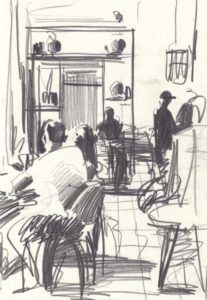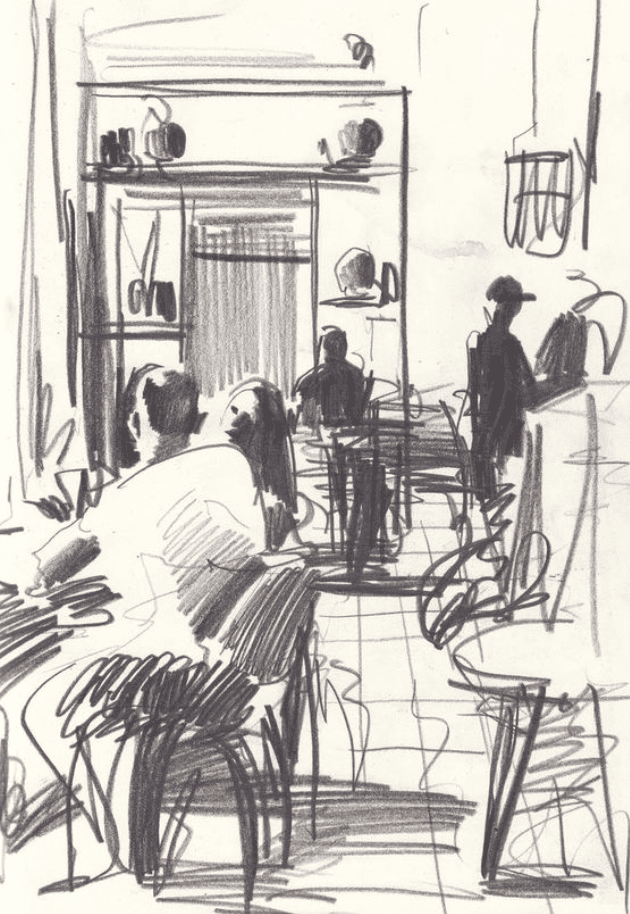
In the bottom-right corner of a peninsula in the very Southeast of the United States lies a grid. You can walk off the beach, get in a car, drive straight for 40 minutes west, and reach the end of the world. Civilization, chopped into perfect little squares of gated neighborhoods and golf courses, suddenly ends. The urban doesn’t slip easily into the surrounding nature. Instead, it’s the whiplash of a swimming pool in a backyard looking out over miles and miles of flat rivergrass.
In winter, the humidity drops low enough to hear the sound of the interstate. The five-lane wide highways are likely 10 lanes by the time I write this. Besides the on-ramps are massive, gaping sewer holes that drop down into hell, probably. Trapped in a strip between the ocean and the Everglades, each hurricane is preceded by a sea of red bumper lights crawling towards the only escape available: North.
This Disney-world adjacent simulation is mostly all I’ve ever known. For a lot of people, this anvil of civilization dropped on top of the landscape just goes on and on, expanding to cover the whole globe. There is no other reality. It takes a lot to realize that where you come from is really just a mirage, an oasis built into an expansive desert. The grid doesn’t sprawl outwards. It merely juts out piece by sharp piece into the green. Florida has managed to create an artificial reality that feels imposed upon the natural world.
Then I moved to Europe. I noticed the wooden-doored church on every corner, the rusted fountains in the squares, the stone steps in an office building that sloped downward from years of use. The people around me conducted their daily business — did their groceries, walked their children to school, took their coffee — in spaces centuries older than the founding preamble written on the front page of my passport. They were nonchalant about it. It was all normal. Such spaces were everywhere. Not protected, not historical monuments, not even something to think twice about. There was a feeling of a past which existed long and far behind each place. They all had stories. They felt lived in. They felt cultured.
That’s the word that many Americans return with. “Europe is so cultured,” they say. What they really mean is: Europe is so old. Europe is so historic. Europe (the entire continent) feels like you’re in an old film in the South of France because it’s all just so aesthetically pleasing.
There’s a belief that history is what makes a place special. It’s the sense that if so many generations of people have wanted to live out their days here, then it must be important. If thousands of people can trace their ancestry back to the first emigrating boats, then it’s surely a city of higher value than other “newer” cities. “Pre-war” is the new equivalent of “charming”.
It is not history, and it is not antiquity or tradition, which determines which cities are more interesting or more “cultured.” Too often, we fall into the mindset that culture is something that has to be developed over time. Western Europe is supposedly the pinnacle of beautiful architecture because it’s nothing like the modern glass structures we build today. It’s as if the communities that came to be in the last 100 years have yet to be worn in. Like leather. They need to be stretched out for centuries in order to fit the many stories, accumulated traditions, and shared histories that constitute a place of value. But the reality is that we don’t purchase vintage clothes because they’re old. The thrift-store gem is a gem because it is unique. It’s the perfect size along with the perfect color along with the perfect detailing that fits a specific style.
Creating the culture of a city is about more than just how long it has existed in the Western imagination. It’s about transience, how long people decide to stay, the interactions that are only made in “third spaces” away from work and home, how the “non-places” that serve no real purpose are decorated. It’s about having local street art rather than a bus stop full of ads which are currently running in every major city. Rather than cookie-cutter residential buildings, the architecture is distinguishable. You can stand in the middle of an intersection without feeling like you could literally be in any gentrified neighborhood in the world.
Astana, the capital of Kazakhstan, is a 20-year-old city that embraces its newness as well as its position as the unique intersection of several cultures. Modern buildings are constructed with Islamic and traditional Kazakh influences, creating a city that looks like a science fiction movie. The architecture is a unique expression of the nation’s identity. In many cities, genocide and colonization have made it difficult to find a sense of shared history.
Lima contains a mix of newer colonial styles with massive clay huacas (pyramids) dotting the corners of residential districts. The restaurant culture has become largely defined by the city’s position on the Pacific Ocean, abundant in influences from the local Japanese immigrant community. The whole city feels like a fusion of the past, present, and future.
It seems that urban “culture” is about a shared willingness to exist in the same spaces, not just co-exist. It’s about accommodation, not age. The walled city of South Florida with its wide boulevards is a deliberate division. It is a purposeful separation from others, not to mention nature. It is the elimination of third spaces. It is a hall of mirrors.
But there are times when it does make space for this feeling of wanting. The road signs written in English, Spanish, and Haitian Creole for the displaced New Yorkers to find their way to the beach is something that is uniquely Florida. People want to make space for others. When people are conscious that there are others sharing these spaces, there arises a distinct “culture” that is different from anywhere else. Rather than the year in which a city’s foundation was first poured, what gives it this “culture” is the unique mix of people, identities, and influences.
What is wrong with many American cities is that this shared willingness to exist together has been erased. Whether the culprit be excessive car culture, commercialization, or in-your-face advertising, people aim to get from point A to point B while avoiding as many other people as possible. And this doesn’t have to mean having a chat with a stranger on the subway. It’s the shared recognition — whether it’s of street art, public parks, and less “gating” of communities — that there are other inhabitants of your space, and that’s okay.
Other posts that may interest you:
- The Trouble with ‘Ecocide’
- Carbon dioxide removal – hit or miss?
- Local Victories for Turkish Opposition — A Sign of Hope?
- Are France and Japan a Mismatch Made in Heaven?
- A Reflection on Dark Tourism
Discover more from The Sundial Press
Subscribe to get the latest posts sent to your email.





